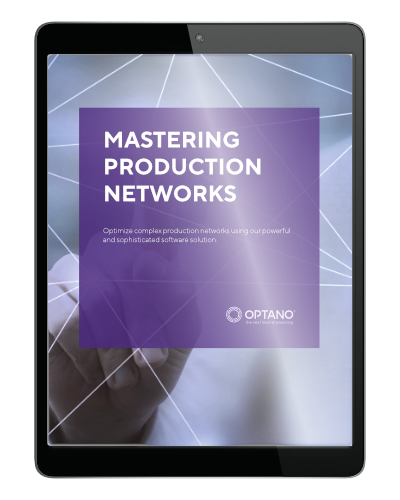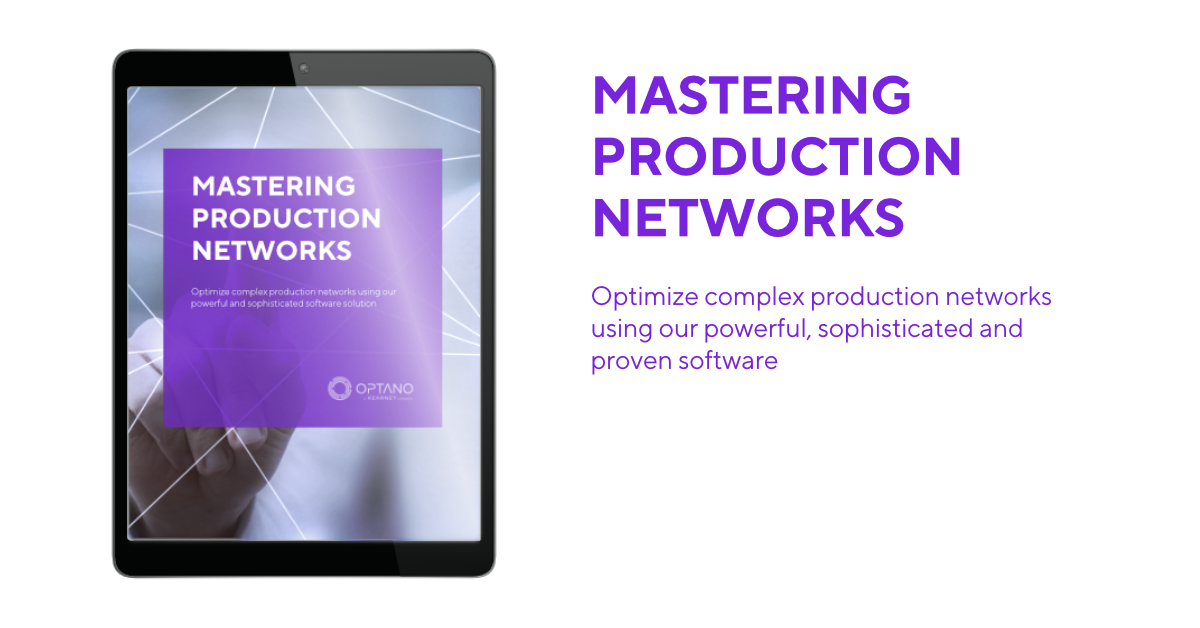Network planning using advanced analytics
In our blog Challenges in planning production networks, we already addressed the requirements that are placed on modern production networks: delivery reliability must be ensured, cost and transport advantages must be exploited, and risks must be minimized. As a result, production networks should be powerful and efficient.
As part of his work as a product manager at Kearney, Dr Jonathan Fritzemeier deals with precisely this topic. In this interview, he tells us how production networks can be designed efficiently with the help of advanced analytics.
What challenges do companies face when planning or optimizing production networks?

Our clients‘ production networks are becoming increasingly complex. There can be various reasons for this: many companies’ networks have grown historically – without any “systematic planning”. The motives behind relocating or expanding production to other locations, for example by acquiring new companies, are also varied: to cut costs, increase flexibility and resilience or to access new markets. Without the right tools, classic production planners are simply overwhelmed. They do not have an overview of the entire network and this makes proactive planning difficult.
What’s more, there are often additional restrictions. For example, in the form of client requirements. A client may call for goods to be delivered from one particular factory only. These restrictions are often not taken into account at the strategic planning level.
Management of production networks has changed
Are there any factors that have changed the way production networks are managed, particularly with regard to the events that have taken place in recent years?

The requirements have certainly changed in two respects:
There has been a growing desire among companies to examine their networks for more redundancy and then implement it. This increases flexibility in production while strengthening resilience along the entire value chain at the same time. The crises we have witnessed in the last few years have shown just how important issues like redundancy and resilience have become.
Sustainability is becoming increasingly important in the development of production networks – and indeed along the entire value chain: from the supplier to delivery to the end customer. Climate change and the growing shortage of resources are issues that have gained significance in our society and in politics.
Consumers are increasingly looking to buy more sustainably manufactured products. Co-decision-makers such as shareholders want the company to have a positive image. And last but not least, the number of legal requirements in favor of environmental protection is rising.
By using Advanced Analytics, a production network can be optimized quite easily with regard to the above-mentioned factors – and, if desired, can also go one step beyond. For instance, CO2 emissions for the entire value chain can be analyzed and improved. With the right tool, this is even possible for the CO2 balance of end products.

In your opinion, what would a perfectly functioning production network look like and what are the most important requirements for this?

In my view the question is not so much about what the network looks like now. It is far more important to ask: Do the decision-makers have a sufficient overview and control? A network that runs perfectly today may be the wrong one for the company’s future tomorrow.
If you want to have a future-proof production network, then you need to use the right tools. Only then can the amount of data that is generated within such a structure be harnessed. Firstly, to create transparency, and secondly, to be able to respond quickly to any changes. The goal must be to have an optimally configured network again after you have responded to the perturbations. Data quality is also an important pre-requisite for these tools to work properly.
Can you describe a „typical“ optimization project for production networks at Kearney, and when and how does OPTANO come into play?

I don’t think there is such a thing as a typical network project. Every client and every production network is unique. This is what makes the task so diverse.
Such a project mostly starts off with an initial phase to define the scope of the project and the pre-requisites. In this phase we also evaluate which Advanced Analytics methods we want to use. And this is where OPTANO comes into play: Kearney began developing planning software for production networks with OPTANO several years ago which we have constantly been improving based on the feedback from our users. Furthermore, we can work together with OPTANO during the course of the project to make adjustments for our clients so that we can really meet all their requirements 100%. Standard software cannot accomplish that.
Simply put, Kearney’s experts collect all of the necessary data, perform the optimization and prepare the results for decisions at CXO level. After that, Kearney often accompanies the implementation of the decisions. Kearney also supports the continuous planning of production networks with the OPTANO solution by integrating the software and training the users. Many of our clients, from the planners to the CEOs are greatly impressed by the OPTANO solution.
Advanced Analytics is the future for a variety of planning topics
In your opinion, what are the advantages of using software like OPTANO which deploys mathematical methods like Advanced Analytics?

I’m a big fan of mathematical optimization because I can be certain that the best results will be found – results which are scientifically based. With regard to the various planning aspects we can also provide answers to questions like:
“How much will it actually cost me to commit to a particular supplier?”
In my view, Advanced Analytics is the future for many planning challenges. If you plan manually, for example with Excel, there are always inaccuracies and no guarantee that you will get the best result. Added to that, the complexity of many planning challenges is continuing to grow so that manual planning is no longer feasible.
Which feature of the OPTANO solution for production networks do you like best of all?

The thing I like best about OPTANO is that you have the opportunity to generate new scenarios very quickly and compare them with previous ones. This enables you to find answers to questions such as: “Which additional costs can I expect if I have to reduce my CO2 emissions by 50%?”
By using scenarios and comparing them with one another, different alternative situations and recommended measures can be weighed up against one another. In other words, scenario comparisons allow you to respond to new requirements in a very short time.
Thank you very much, Jonathan, for taking the time to talk to OPTANO.
You will find more information on the OPTANO solution for production networks here or you can download our factsheet on this topic below.
Do you already know our
factsheet on this topic?

Managing complex production networks is challenging. There is often a lack of the necessary transparency to coordinate requirements and production capacities in such a way that the availability of goods and production costs are in an optimal relationship. In this factsheet, we show the possibilities offered by the OPTANO solution for production networks. In this factsheet we would like to share what we have learned over the course of numerous projects on how to successfully complete an optimization project.
To obtain our factsheet, all you need to do is enter your contact details in the space below. A pop-up window will then open to download the whitepaper. Please note that by providing us with your email address, you agree that we may contact you on this topic. You may revoke this agreement at any time by contacting privacy@optano.com.



